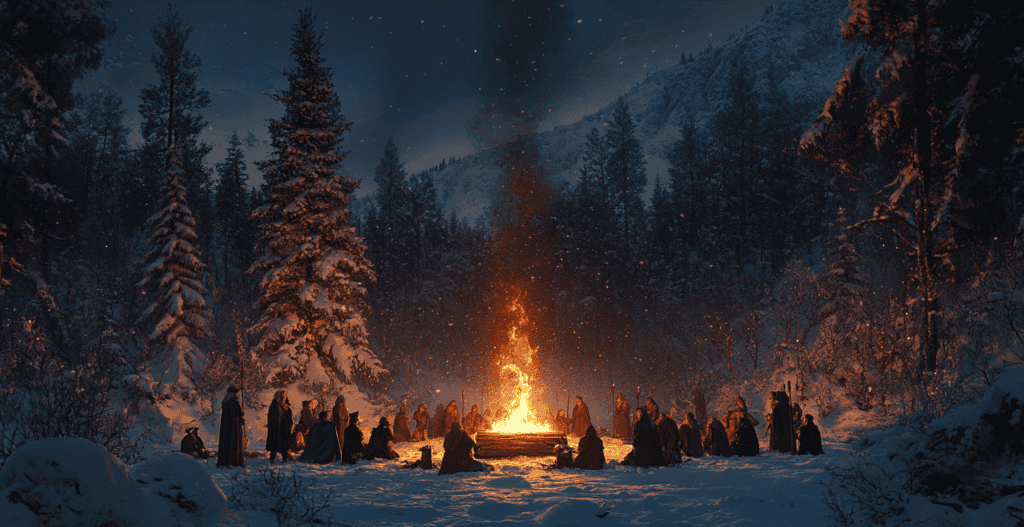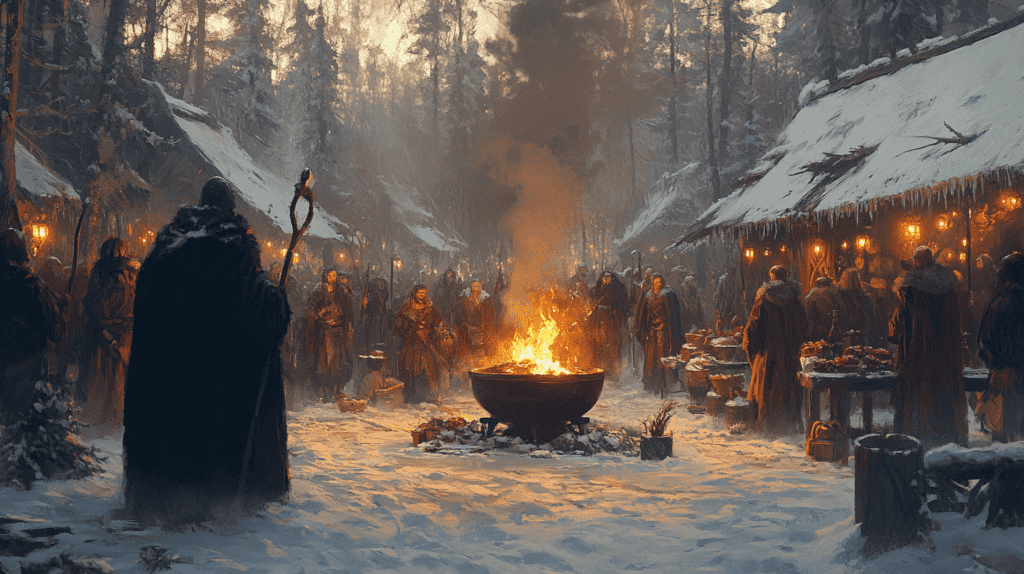
The Norse celebration of Yuletide, known as Jól in Old Norse, was a vibrant and meaningful midwinter festival that marked the turning of the year and honored both gods and ancestors. This ancient tradition, deeply rooted in Norse culture, combined religious rituals, feasting, and community bonding during the darkest days of winter.
Timing and Duration
Yuletide typically fell between mid-December and mid-January, though the exact dates could vary. The celebration lasted for three days and nights, centered around the winter solstice. The festival’s timing was intrinsically linked to the lunar calendar, with the Norse adding an extra month every eight years to realign time and seasons.
Religious Significance
Yuletide held profound religious importance for the Norse people, serving as a time when the boundaries between the mortal world and the realm of gods and supernatural beings were believed to be particularly thin.
Several Norse deities were closely associated with the Yuletide celebrations:
Odin: As the All-Father and god of wisdom, Odin was invoked for protection and guidance during the harsh winter months.
Freyr: The god of fertility and prosperity was honored for blessings on the harvest and provisions for winter.
Freyja: Goddess of love and fertility, Freyja was worshipped for her connection to magic and Seiðr.
Thor: The god of thunder was called upon for protection against the dangers of winter and to keep away threatening creatures.
Njörðr: Along with Freyr, Njörðr was hailed for peace and fertility.

Ancestral Veneration
Yuletide was also a time to honor deceased ancestors. The festival was believed to be when the spirits of the dead passed on to the Otherworld. This belief led to the practice of animal sacrifices in honor of these spirits and a wariness of venturing out alone at night during Yule.
Blót: The Sacred Sacrifice
A central part of Yuletide was the blót, a sacrificial ritual aimed at gaining the favor of the gods. This solemn ceremony involved:
- Sacrificing animals, typically farm animals.
- Collecting the blood in bowls.
- Sprinkling the blood on altars, walls, and participants using twigs believed to have magical properties.
- Cooking the sacrificed animals over the hearth fire.
The blót was not only a religious act but also provided the feast for the celebration.

Sumbel: The Ritual Drinking Ceremony
The sumbel was a formal drinking ritual that strengthened community bonds and honored gods and ancestors. During this ceremony participants raised cups in honor of gods and ancestors with toasts were made to Odin for victory, to Njörðr and Freyr for peace and good harvests, and to departed friends and family. The king or chieftain blessed the sacrificial meat and the ceremonial beaker.

Yule Oaths
A unique aspect of Yuletide was the swearing of Yule oaths. These promises, made during the celebration, were considered unbreakable by pagan law. Breaking such an oath could have severe consequences, potentially even resulting in death.
Some Norse sources mention a custom called heitstrenging, performed on Yule evening. This ritual involved placing hands on a pig called sonargöltr (sacrifice-boar) and swearing solemn oaths. In some traditions, the pig was considered holy, devoted to Freyr, and sacrificed after the oath-swearing.
The Yule Feast
Yuletide was not just a time of solemn ritual but also of joyous celebration and feasting. The sacrificial animals from the blót formed the centerpiece of the Yule feast. This abundant meal was a time of community gathering and celebration. The feast could last as long as the ale continued to flow, sometimes extending the celebration beyond the traditional three days.
Special ale brewed for the occasion, known as Yule ale, played a significant role in the festivities. The tradition of “drinking Jól” was an integral part of the celebration.
The burning of the Yule log was a central tradition. Often lit with a piece of wood from Thor’s sacred oak tree, the log symbolized the god’s power and protection. The ashes from the Yule log were believed to ward off evil spirits and misfortunes. These ashes were often kept to ignite the following year’s Yule fire, creating a continuous cycle of protection.

Legacy and Modern Influence
The Norse Yuletide has left an indelible mark on modern winter celebrations, particularly Christmas. Many Yuletide traditions were incorporated into Christian practices during the Christianization of Norse lands. Elements such as the Yule log, the use of evergreen decorations, and the emphasis on feasting and community gathering have all found their way into contemporary Christmas celebrations.




